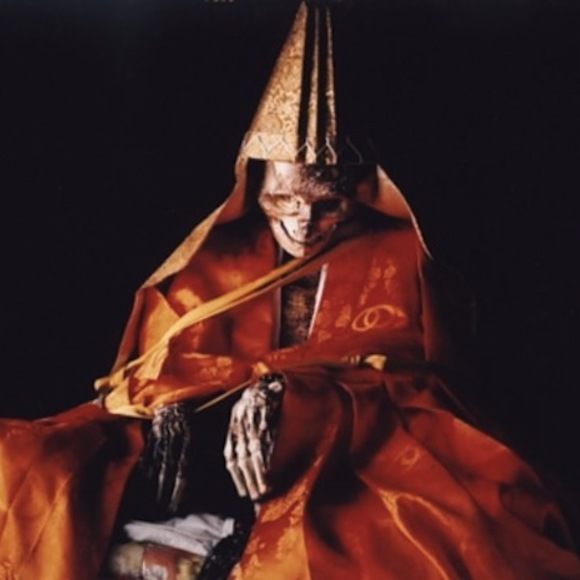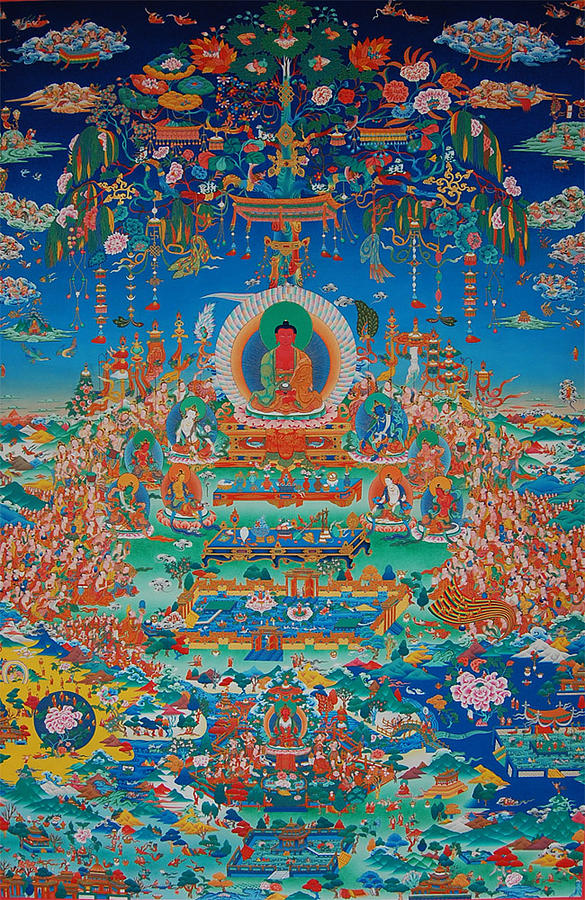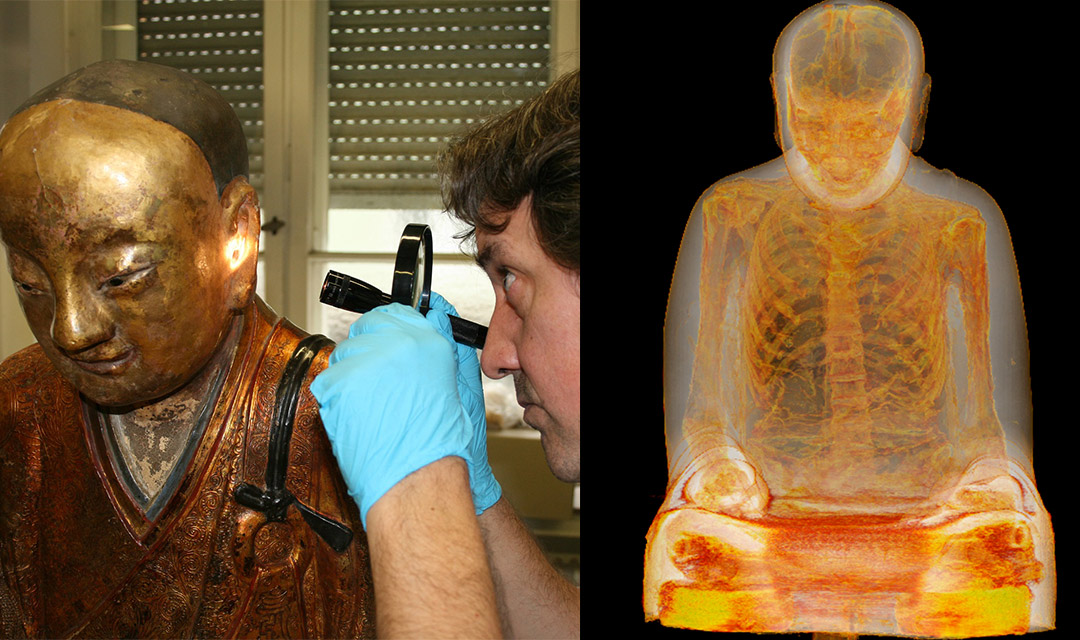It looks like you're using an Ad Blocker.
Please white-list or disable AboveTopSecret.com in your ad-blocking tool.
Thank you.
Some features of ATS will be disabled while you continue to use an ad-blocker.
14
share:

After a punishing 1000-day ritual diet, practioners would, it is believed, drink a kind of toxic tea and wait to die. The practice was thought to produce "Buddhahood in this very body..." But it was eventually banned as a barbaric form of slow suicide.
Were these old practioners onto something...or merely fanatics taking things too far?
www.atlasobscura.com...
Between 1081 and 1903, at least 17 monks managed to mummify themselves. The number may well be higher, however...
The process of self-mummification is long and arduous, taking at minimum three years of preparation before death. Central to this preparation is a diet called mokujikigyō, literally “tree-eating training.” ...
...For a thousand days, the mokujikigyō diet limits practitioners to only what can be foraged on the mountain, namely nuts, buds, and roots from trees. Some sources also report that berries may have entered the diet, as well as tree bark and pine needles. Time not spent foraging for food was passed in meditation on the mountain.
From a spiritual perspective, this regimen was intended to toughen the spirit and distance oneself from the common human world. From a biological point of view, the severe diet rid the body of fat, muscle, and moisture while also withholding nutrients from the body’s natural biosphere of bacteria and parasites. The cumulative effect was to arrest decomposition after death.
At the completion of a thousand-day cycle on this diet, practitioners were considered spiritually ready to enter nyūjō. However, most monks completed two or even three cycles to fully prepare themselves. After the final cycle, the devout would cut out all food, drink a limited amount of salinized water for a hundred days, and otherwise meditate upon the salvation of mankind while waiting to die.
I am generally a freedom of religion person.
I get that this seems barbaric, but at the same time, if these are people choosing this freely, who are we to stop them from it? This is quite aside, you understand, from whether or not I think it works. Also, it says only about 17 ever managed it in the rough century it was practiced, so I am guessing it was not a popular route to attempt or if it was, not many managed to stick it out.
I'd call this one less barbaric than the Indian practice of throwing a dead man's widow on to his funeral pyre at any rate which was also banned, and often I think that one was far less voluntary on the part of the widow. After all, if you decide to back out of this, it would be easier to reverse than leaping out of a roaring funeral pyre (*note: I am guessing it may have been the Brits who had a hand in banning this, but I could be wrong).
I get that this seems barbaric, but at the same time, if these are people choosing this freely, who are we to stop them from it? This is quite aside, you understand, from whether or not I think it works. Also, it says only about 17 ever managed it in the rough century it was practiced, so I am guessing it was not a popular route to attempt or if it was, not many managed to stick it out.
I'd call this one less barbaric than the Indian practice of throwing a dead man's widow on to his funeral pyre at any rate which was also banned, and often I think that one was far less voluntary on the part of the widow. After all, if you decide to back out of this, it would be easier to reverse than leaping out of a roaring funeral pyre (*note: I am guessing it may have been the Brits who had a hand in banning this, but I could be wrong).
This is a really cool topic. From what I remember they do this to transform into their light body. Apparently there have been many witnesses to this
and if I remember correctly there was a practitioner who recently did it I think sometime between 2014-2017.
Apparently there were witnesses that said they could see bright light coming from between the mummification fabric during this process. A lot of the bodies shrink dramatically in size also, much more then you would see in Egyptian mummification for example.
If I remember where I read this or saw it I will come back and post the info.
S & F!
Apparently there were witnesses that said they could see bright light coming from between the mummification fabric during this process. A lot of the bodies shrink dramatically in size also, much more then you would see in Egyptian mummification for example.
If I remember where I read this or saw it I will come back and post the info.
S & F!
The medieval Japanese Buddhists had a number of gruelling rituals. The Tendai sect had a 90-day practice called "walking meditation". The practioner
would circle a statue and chant a certain phrase over and over. They were allowed to stop for the toilet and they were fed, but they had to eat
standing up. Under no circumstances could they sleep or lie down.
Many practioners died or went insane midway through the ritual.
It was attempted some years ago for the first time in a century or so, against much protest. The monk completed the ritual. He said after 9 days his legs were unnaturally swollen and "every step was like walking on needles."
Yet despite the pain he persisted. He said that after some more days, the swelling went down and a feeling of blissful peace enveloped him. He saw visions of the Buddhist "Pure Land" (see picture below) and could "converse with many Buddhas." After 90 days of constant movement and no sleep, he successfully completed the ritual.

Many practioners died or went insane midway through the ritual.
It was attempted some years ago for the first time in a century or so, against much protest. The monk completed the ritual. He said after 9 days his legs were unnaturally swollen and "every step was like walking on needles."
Yet despite the pain he persisted. He said that after some more days, the swelling went down and a feeling of blissful peace enveloped him. He saw visions of the Buddhist "Pure Land" (see picture below) and could "converse with many Buddhas." After 90 days of constant movement and no sleep, he successfully completed the ritual.

a reply to: Never Despise
Really..quite easy to do. One must meditate in and during, refusing food, water, movement.
A form of extreme "projection inward". At that point...one stays in thought, doesn't move and our bodies atrophy.
Quite interesting
Really..quite easy to do. One must meditate in and during, refusing food, water, movement.
A form of extreme "projection inward". At that point...one stays in thought, doesn't move and our bodies atrophy.
Quite interesting
I remember touching upon this subject in religious studies in college. I don't recall the self mummification aspect but do recall that some monks
would tie themselves in a lotus position and basically, "die" consciously, leaving their body, never to return and move into the beyond with wakeful
consciousness. I have had some OOBE's(out of body experience) during intense meditations and got scared about not being able to renter my body. This
fear immediately shot me back into my body and I remember wondering if it would be possible, through intended practice, to maintain that consciousness
and drift into the ether to nirvana or whatever one may call it, leaving the the body behind. Would one's consciousness be limited to this physical
realm? I have heard of people during OOBE's going into into space and/or other dimensions and I do wonder if this traveling consciousness would be
stuck in this Earth plane.... and would consciousness exist adrift even after the brain dies.
I found this notion fascinating and felt it could be possible to consciously and willingly depart one' s body never to return....maybe?
I found this notion fascinating and felt it could be possible to consciously and willingly depart one' s body never to return....maybe?
Didn't buddha starve himself during his path towards finding enlightenment? Only to find it no use?
It seems to go against buddha's path toward enlightenment.
Correct me if im wrong.
Very interesting practice though. Can't imagine the level of discipline.
It seems to go against buddha's path toward enlightenment.
Correct me if im wrong.
Very interesting practice though. Can't imagine the level of discipline.
originally posted by: Never Despise
Statue encasing body of self-mummified practioner.
source
Everything obviously went as planned. He is smiling
originally posted by: blueman12
Didn't buddha starve himself during his path towards finding enlightenment? Only to find it no use?
It seems to go against buddha's path toward enlightenment.
Correct me if im wrong.
Very interesting practice though. Can't imagine the level of discipline.
You are correct that Guatama Buddha preached against extreme ascetic practices, after having given it a try.
But asceticism had a way of slipping into Buddhism from time to time. Buddhism also has a long (and controversial) tradition of self-immolation.
There was/is another religion in Japan called "Shugendo" that practiced various ascetic exercises. It is practiced in the remote mountains and influenced / was influenced by Buddhism. Note that this self-mummification doesn't seem to have been a mainline Buddhist practice but a rare event in the remote Northern part of Honshu. It was probably influenced by the Shugendo tradition (although they never had anything this extreme AFAIK.)
The key to understanding it is that it is an attempt at achieving "Buddhahood in this very body." It wasn't so much about mortifying the flesh for the sake of punishment, or escaping through OOBEs. It was an almost alchemical transformation of the body with Buddhahood as the goal. And such mummified monks, though clearly dead, seem to have been considered still living in some strange way, or subsisting in a state beyond life and death.
Japan also has a long tradition of treating certain Buddhist statues as living entities, placing food and water before them and treating them as real Buddhas rather than "representations" or art. Perhaps these dead monks were considered "real Buddhas" in a similar way.
edit on 11-12-2020 by
Never Despise because: (no reason given)
Sometimes I feel like I’m going to do this involuntarily one day. I’m just going to crack and sit under a tree, never to move again. We’ll see
how 2020 goes.
a reply to: Drucifer
Friend? 2020 has gone. Therefore, WAS. The moment now, is the moment passed...and today will be yesterday...tomorrow.
Enlightenment accepts all things as part of a greater, singular 'whole". Pos/neg and ying/Yang.
One with all things is true enlightenment.
*PS: see SMILING BUDDA!
Friend? 2020 has gone. Therefore, WAS. The moment now, is the moment passed...and today will be yesterday...tomorrow.
Enlightenment accepts all things as part of a greater, singular 'whole". Pos/neg and ying/Yang.
One with all things is true enlightenment.
*PS: see SMILING BUDDA!
edit on 11-12-2020 by mysterioustranger because: (no reason given)
I remember a story about a valley with several villages in what is today China were a local legend told of a time when great disaster had befallen
there community and how there crop's had suffered and people were starving, a wandering monk came through and walked into a cave instructing them to
seal the entrance he then kneeled and meditated until he died to try to balance the bad karma that had brought ruin upon the valley.
In the 20th century some Chinese scientists stumbled upon a cave in this valley with the entrance sealed up with a roughly made stone wall and breaking through they found a mummified monk sitting in the lotus position still holding his meditation beads, they removed him and as soon as they did the weather in the valley turned foul despite it being late spring, the river flooded destroying several homes and damaging crop's and villages and so the local's begged (forced or almost rioted read between the lines) the officials whom had already boxed him up to be sent to some university or other in Beijing many thousands of miles away to give them back there monk, he was put back into the cave and the entrance re-sealed and the weather went back to normal.
Now I may have gotten my rendition of that tale I read about many years back a bit garbled but I though you would find it an interesting addition since it also has a mummified Buddhist monk whom did this to himself to try to save many people.
In the 20th century some Chinese scientists stumbled upon a cave in this valley with the entrance sealed up with a roughly made stone wall and breaking through they found a mummified monk sitting in the lotus position still holding his meditation beads, they removed him and as soon as they did the weather in the valley turned foul despite it being late spring, the river flooded destroying several homes and damaging crop's and villages and so the local's begged (forced or almost rioted read between the lines) the officials whom had already boxed him up to be sent to some university or other in Beijing many thousands of miles away to give them back there monk, he was put back into the cave and the entrance re-sealed and the weather went back to normal.
Now I may have gotten my rendition of that tale I read about many years back a bit garbled but I though you would find it an interesting addition since it also has a mummified Buddhist monk whom did this to himself to try to save many people.
new topics
-
Trump Presidential Transition Team will not use GSA or Government entities to come to DC
US Political Madness: 6 minutes ago -
Mind Blowing Cave under someones land
Fragile Earth: 27 minutes ago -
The Party of Peace - Trump Cabinet Picks Targeted with Death Threats
US Political Madness: 1 hours ago -
V.P. Kamala Harris releases a video and nobody understands why
US Political Madness: 4 hours ago -
D.B. Cooper mystery may be solved
General Conspiracies: 8 hours ago
top topics
-
D.B. Cooper mystery may be solved
General Conspiracies: 8 hours ago, 19 flags -
V.P. Kamala Harris releases a video and nobody understands why
US Political Madness: 4 hours ago, 14 flags -
The Party of Peace - Trump Cabinet Picks Targeted with Death Threats
US Political Madness: 1 hours ago, 6 flags -
Mind Blowing Cave under someones land
Fragile Earth: 27 minutes ago, 2 flags -
Trump Presidential Transition Team will not use GSA or Government entities to come to DC
US Political Madness: 6 minutes ago, 1 flags
active topics
-
Mind Blowing Cave under someones land
Fragile Earth • 3 • : onestonemonkey -
Trump Presidential Transition Team will not use GSA or Government entities to come to DC
US Political Madness • 0 • : matafuchs -
I thought Trump was the existential threat?
World War Three • 101 • : cherokeetroy -
Ed Dowd some good news
Medical Issues & Conspiracies • 40 • : KrustyKrab -
V.P. Kamala Harris releases a video and nobody understands why
US Political Madness • 35 • : Xtrozero -
The Party of Peace - Trump Cabinet Picks Targeted with Death Threats
US Political Madness • 4 • : nugget1 -
-@TH3WH17ERABB17- -Q- ---TIME TO SHOW THE WORLD--- -Part- --44--
Dissecting Disinformation • 3385 • : Thoughtful3 -
Well, here we go red lines crossed Biden gives the go ahead to use long range missiles
World War Three • 401 • : Xtrozero -
Interesting Video-UFO?
Aliens and UFOs • 19 • : Schmoe3755 -
Post A Funny (T&C Friendly) Pic Part IV: The LOL awakens!
General Chit Chat • 7835 • : underpass61
14


